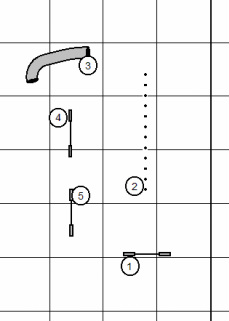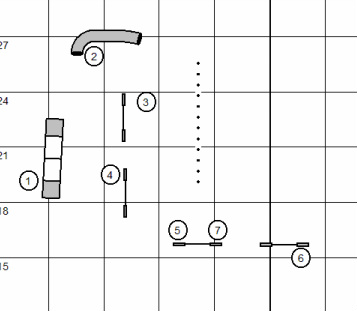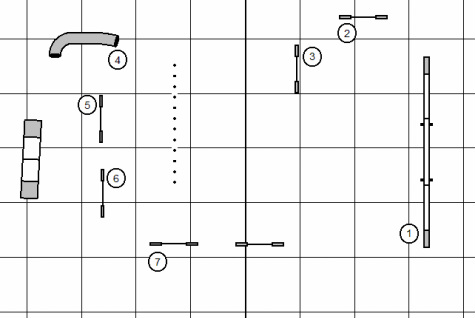Today Dylan and I went to a group training session with Toni Dawkins, organised by Amanda Pigg. Not too far for me to travel but there were others that had driven over an hour. I would say we had about 2.5 - 3hrs of training with several different points covered, including individual correction during practice.
Course 1: weaves and a blind turn

Five obstacles with a number of options. Some people wanted to work on independent weaves. After our first attempt where Dylan came out of the last weave :-( we then worked the course with Toni at the end of the weaves with a reward. The idea was that we could peel away from the weaves but the dog finishes the weaves before being directed to the next obstacle. In fact I was quick enough to get between the tunnel and fence 4 anyway, but independent weaves seems like a good option. Dylan liked Toni and would happily play tug with her :-)
Next was a "blind turn" after the tunnel to direct the dog over 4 but at a angle which minimised the distance between 4 and 5. For me that was okay as I have been trying that with tunnels in my normal training and in competitions as well. What I learnt was that the dog looks for the cheek and comes to that side of you regardless of which arm is out, so turning you head slightly towards the side you want the dog is important.
The third part was driving Dylan on at the last fence with "GO" command and a toy to go to (Toni with a toy in this case). This is what I need to do with tunnels in actual fact ... if I am behind Dylan I want him to drive forward anyway unless I say so, so have a toy in front to drive Dylan on even when I am behind him.
Next was a "blind turn" after the tunnel to direct the dog over 4 but at a angle which minimised the distance between 4 and 5. For me that was okay as I have been trying that with tunnels in my normal training and in competitions as well. What I learnt was that the dog looks for the cheek and comes to that side of you regardless of which arm is out, so turning you head slightly towards the side you want the dog is important.
The third part was driving Dylan on at the last fence with "GO" command and a toy to go to (Toni with a toy in this case). This is what I need to do with tunnels in actual fact ... if I am behind Dylan I want him to drive forward anyway unless I say so, so have a toy in front to drive Dylan on even when I am behind him.
Course 2: A frame, Grab Hands and lines for the dog

Toni asked me what kind of contacts Dylan did on the A frame. My answer was that he doesn't stop! If he doesn't stop we'll do a running contact then she said. A piece of guttering was placed across the A frame above the contact, which will help Dylan lengthen his stride onto the contact. Toni told me to run to the tunnel entrance and we'd see what he did. A perfect running contact apparently!
"Grab hands" means reach behind you with the appropriate hand and pretend you're grabbing the dog and pulling him along the line you want. If the dog is behind you so should your hand be. So grab hands were used from the tunnel to fence 3 (from either side as you can grab over a fence as well) and then again at fence 6 to grab the dog to complete a tight turn around the wing closest to fence 7. I choose to grab Dylan with me right hand going into fence 3, arm out form 4 and 5 (straight line though) and then reach and grab with the left hand to draw the dog around fence 6 and then run in the direction to complete the course. This grabbing manoeuvre is different from anything I have done before and is simple enough for me to remember - effective as well to create a tighter turn on 6.
One chap showed us how if fence 7 jumped the other way you could use a grab hands over fence 7 to draw the dog around 7 after 6. Very effective and without the need to "push" the dog through the gap - the dog just went there anyway because the grab hand was drawing the way. Very clever and effective. Needs practice though :-)
"Grab hands" means reach behind you with the appropriate hand and pretend you're grabbing the dog and pulling him along the line you want. If the dog is behind you so should your hand be. So grab hands were used from the tunnel to fence 3 (from either side as you can grab over a fence as well) and then again at fence 6 to grab the dog to complete a tight turn around the wing closest to fence 7. I choose to grab Dylan with me right hand going into fence 3, arm out form 4 and 5 (straight line though) and then reach and grab with the left hand to draw the dog around fence 6 and then run in the direction to complete the course. This grabbing manoeuvre is different from anything I have done before and is simple enough for me to remember - effective as well to create a tighter turn on 6.
One chap showed us how if fence 7 jumped the other way you could use a grab hands over fence 7 to draw the dog around 7 after 6. Very effective and without the need to "push" the dog through the gap - the dog just went there anyway because the grab hand was drawing the way. Very clever and effective. Needs practice though :-)
Course 3: Grab hands, Pivots or a Squatting position

I thought this was the trickiest course we did. I wasn't sure what Dylan would do on the contact. Anyway he is supposed to stop and Toni encouraged me to keep correcting him to 2 on 2 off, until he gets it, which he clearly doesn't at the moment. I had planned to put a turn in after 2, but Dylan was way too fast and overshot the jump before a turn. I need a "steady" command to help him know something is coming - that actually worked a treat, although still work to do. I guess if I can get a stop on the DW then getting in the right place would be most helpful.
The second part of the course was no issue, grab hand (right hand) over jump 5 and fo me a pivot on 7 to bring Dylan in as tight as possible. That worked beautifully :-) Other options for the turn on 7 are a turn so the dog runs between you and the fence wing OR a sort of squatting position with bum against fence 7 wing roughly where the number 7 is and facing away from the fence. The dog then goes around you and you draw the dog with your right hand (blind turn type of effect). I didn't try this as I am happy with my pivots for now and this created a tight turn anyway. There was much hilarity with the squatting position for obvious reasons and some people made it work well :-)
My thanks to Toni for a great lesson (and much patience) and to Amanda Pigg for organising it for us. I look forward to the next one.
The second part of the course was no issue, grab hand (right hand) over jump 5 and fo me a pivot on 7 to bring Dylan in as tight as possible. That worked beautifully :-) Other options for the turn on 7 are a turn so the dog runs between you and the fence wing OR a sort of squatting position with bum against fence 7 wing roughly where the number 7 is and facing away from the fence. The dog then goes around you and you draw the dog with your right hand (blind turn type of effect). I didn't try this as I am happy with my pivots for now and this created a tight turn anyway. There was much hilarity with the squatting position for obvious reasons and some people made it work well :-)
My thanks to Toni for a great lesson (and much patience) and to Amanda Pigg for organising it for us. I look forward to the next one.
 RSS Feed
RSS Feed